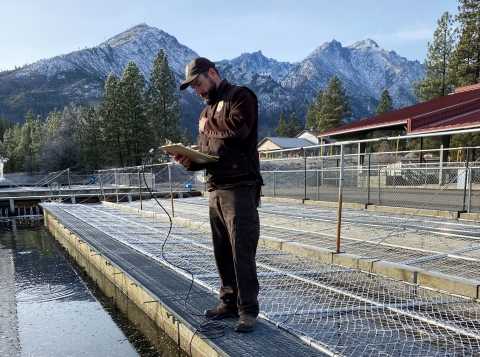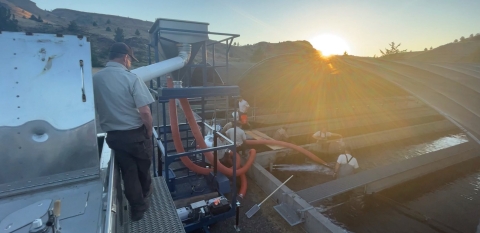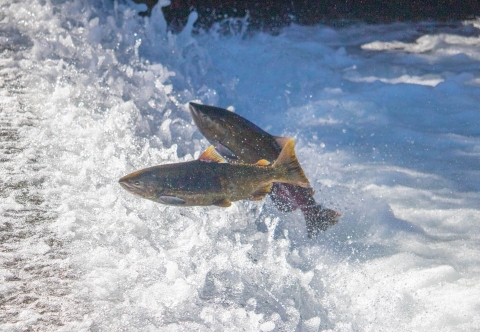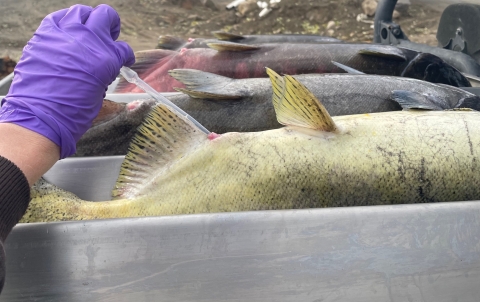What We Do
The Pacific Region Fish Health Program protects the health and welfare of fish living in the wild and on Federal and partner hatcheries in Idaho, Oregon, and Washington. With healthy fish we can be confident that fish survive in the wild to support the Service’s mitigation and recovery goals.
The goal of the Fish Health staff is not to treat diseases, but to prevent them. To achieve that goal requires careful biosecurity, careful husbandry by hatchery staff, detailed knowledge of the fish and of the diseases that might occur, and constant vigilance to detect and respond to problems before they become serious enough that fish health is compromised.
The Pacific Region fish health staff works closely with the state and tribal wildlife agencies and fish health staff in the states that we serve, and we are active participants in regional and national fish health organizations like the Pacific Northwest Fish Health Protection Committee, the Washington Co-Managers, and the Fish Health Section of the American Fisheries Society. This collaboration ensures that we share knowledge and expertise with our partner agencies.
The Program studies the health of fish living in the wild through participation in the FWS National Wild Fish Health Survey. Our work in wild fish is designed to help us to better understand how diseases impact fish populations, to monitor for the impacts of climate change climate change
Climate change includes both global warming driven by human-induced emissions of greenhouse gases and the resulting large-scale shifts in weather patterns. Though there have been previous periods of climatic change, since the mid-20th century humans have had an unprecedented impact on Earth's climate system and caused change on a global scale.
Learn more about climate change on disease severity and distribution, and to assess potential risks for diseases that might move from the wild into hatcheries.
Our veterinarians are active participants in the training of new fish-health-oriented veterinarians. We provide field experience to supplement their formal education. These experiences are provided both on an ad-hoc basis, and through our active participation in a regional consortium of agencies dedicated to producing new veterinarians with fish health expertise.
How we approach disease challenges
Like humans, fish are subject to diseases caused by bacteria, viruses, fungi, and parasites. Most of these diseases are well established in wild fish populations as part of the normal balance of nature, but they can cause problems when they move into hatcheries where there are large populations of susceptible hosts. These movements occur through adult salmon returning to hatcheries from the Pacific Ocean, from hatchery water supplies that use creek water where wild fish are present, and from movements of birds and other animals onto the hatchery. Fish can also be afflicted by non-infectious diseases caused by environmental conditions, nutrition, or genetics.
For hatchery fish, an important goal is to prevent the introduction and spread of infectious diseases. We do this by controlling the movement of wild animals onto hatchery facilities, by using disease-free spring or well water wherever it is available, by disinfecting the surface of fish eggs to prevent the movement of diseases from adults to their young, and most importantly, by making sure that hatchery fish are in such good physical condition that they can fight off disease organisms before serious infections occur.
In addition to concerns about the impact of common diseases on wild and hatchery fish, we also work hard to prevent new fish diseases from being introduced into the Pacific Northwest. The primary tools are strict limitations on fish movements both into and within the region, and very demanding requirements for disease inspections prior to moving fish or releasing hatchery fish into the wild. The disease rules for fish movements are set by Service policy, by state and federal laws, and through Service participation in regional agreements designed to protect fish health.
All fish raised or held on Service facilities are closely monitored for disease by the Pacific Region Fish Health Program. This includes routine visits to look for the presence of fish disease organisms in healthy fish, pre-release and pre-movement inspections, and the diagnosis of the cause of any disease outbreaks that occur. Fish Health staff carry microscopes and other field diagnostic equipment with them on their hatchery visits, and they collect samples for submission to the Washington State University, Washington Animal Disease Diagnostic Laboratory (WADDL). The WADDL is known nationally and internationally for its expertise if fish health diagnostic testing, especially for Pacific salmon. The lab uses state of the art diagnostic equipment, board certified experts, and conducts its work under the strictest accreditation.
When diseases are detected on Service hatcheries, a diagnosis is reached based on field tests, testing conducted at WADDL, and on the expert knowledge of both hatchery and Fish Health Program Staff. All diagnoses are reviewed by PRFHP veterinarians. Should a disease treatment be necessary, it is done under strict veterinary oversight according to state and federal law. We consider the use of any aquaculture drug, especially antibiotics, to be a last resort and we strive to reduce or eliminate all drug and chemical use.
Ethics and fish welfare
- Fish welfare, human safety, and veterinary ethics are at the forefront of everything that we do.
- Our goal is to prevent diseases, not to treat them. Hatchery managers and fish health staff work closely as a team to protect fish health and welfare.
- Fish are monitored carefully and signs of disease are detected and diagnosed before large numbers of fish are affected.
- All fish disease diagnoses are overseen by licensed veterinarians with expertise in aquatic animal health.
- Advanced diagnostic tests are conducted in a fully accredited veterinary diagnostic lab under strict quality controls.
- As required by law, both the testing laboratory and FWS Fish Health staff report all outbreaks of important fish diseases to state and federal authorities.
- Disease treatments are made only when absolutely necessary to protect fish welfare.
- All drug and chemical use is subject to very strict state and federal laws that protect fish, humans, and the environment. All treatments that we use are done according to these laws.
- On facilities with histories of specific fish diseases, we work to change production schedules, species raised, husbandry methods, water supplies, and nutrition to prevent disease outbreaks. Our goal is not to use fish drugs. Any program that appears to be becoming reliant on drug usage, especially antibiotics, becomes the focus of an intense effort to find other strategies for disease prevention.
- Our fish health staff works under a supervisory structure structure
Something temporarily or permanently constructed, built, or placed; and constructed of natural or manufactured parts including, but not limited to, a building, shed, cabin, porch, bridge, walkway, stair steps, sign, landing, platform, dock, rack, fence, telecommunication device, antennae, fish cleaning table, satellite dish/mount, or well head.
Learn more about structure independent from hatchery managers to ensure that they are able to maintain an independent perspective on the welfare of fish under Service control.
Our Projects and Research
Preventing Disease on Pacific Region Federal Hatcheries and Tribal Partner Hatcheries
Some kinds of salmon, especially spring Chinook, often return from the ocean carrying bacteria that cause a disease in young fish. The bacteria are Renibacterium salmoninarum and the disease that they cause is "Bacterial Kidney Disease," or BKD.
By testing the adult fish, we can collect eggs only from those fish that have low levels of the bacteria and are thus much less likely to pass the bacteria on to their offspring through infected eggs. This spawning method has greatly decreased the impact of BKD on cultured salmon.
Salmon sometimes return from the ocean carrying viruses. The Fish Health Program tests returning broodfish for viruses to prevent the introduction of serious diseases into the young fish raised in hatchery raceways.
The Fish Health Program also monitors the health of all hatchery-raised fish to make sure that disease problems are not developing.
Testing for Fish Disease Problems
Despite our very best efforts at prevention, fish do sometimes develop diseases. These are diseases that are naturally present in hatchery water supplies (rivers and streams) or brought back from the ocean by adult fish. Diseases are treated by changes in their environment (for example, temperature, water flow, feeding) or sometimes through the use of drugs.
Disease diagnosis and treatment in our Fish Health Program is overseen by three veterinarians and other highly trained fish health professionals. Drugs are only used as a last resort and their use is highly controlled by the U.S. Fish and Wildlife Service (Service), FDA (FDA Aquaculture Drug Basics), EPA, USDA, and state authorities.
Protecting the Health of Wild Fish
Every group of fish that we raise is rigorously tested for fish diseases before they leave the hatchery. This ensures that the fish from the hatchery will not cause disease problems for fish already in the wild, and it guarantees that the fish from the hatchery have the best possible chance to survive their trip to the ocean so that they can later return as adults.
Disease inspections and health requirements for the culture and movement of salmon in the Pacific Northwest are governed by the demanding requirements of the states of Washington, Idaho, and Oregon, by tribes, by the Integrated Hatchery Operations Plan (IHOT), by Hatchery Genetics Management Plans (HGMPs), by Service policy, and by federal law.
These include:
• Code of Federal Regulations Title 50
• USDA-APHIS Rules
• World Organization for Animal Health
• Pacific Northwest Fish Health Protection Committee
• Integrated Hatchery Management Operations Team Guidelines
• Washington Co-Managers' Policy
• Oregon State Fish Health Policy
The Fish Health Program also tests thousands of wild fish from throughout Oregon, Washington, and Idaho so that we can better understand the impacts of diseases on wild fish populations.





